
 |
| Team ACP > エコミッション > 2001@ジャパン > 現地レポート > |
| 市民ビオトープ |
| 市民ビオトープ | |
|
|
|
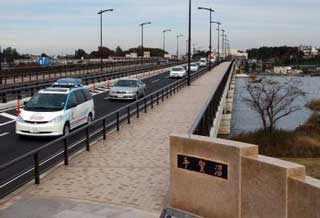 |
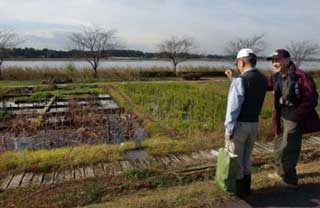 |
| 手賀沼にやってきました | 豊田さんが手がけているところ |
|
|
|
| 日本一汚い沼をご存知ですか?千葉県の北西部に位置する周囲38km、深さ86cm、面積6.5平方km(東京ドームの約1/7)の手賀沼です。昭和20年代まではきれいな沼でウナギの名産地でもありました。東京で食べるウナギのほとんどは、この手賀沼産と言われていたほどです。しかし昭和30年代に入り手賀沼流域では急速に宅地化が進み、下水道も整備されないまま、住宅からの生活廃水によって沼がみるみる汚染されてしまいました。昭和49年以降には水質の汚染度を表すCOD値で全国のワーストワンになってしまいました。 また現在では「アオコ」でも、この手賀沼は有名となっています。「アオコ」とは水の中に含まれるリンやチッソが増えると、これを養分としている植物性プランクトンが大量発生します。植物性プランクトン自身は、リンやチッソを吸収して酸素を吐き出すという水質浄化の作用があるのですが、植物性プランクトンと食用とする動物性プランクトンも同様に大量発生してしまい、その発生量が多すぎると水の中の酸素が欠乏しプランクトンが死に絶えます。この死骸が「アオコ」となって沼に蓄積されます。このアオコも水質汚染の証として手賀沼では夏によく見られます。 このように不名誉な負の遺産・手賀沼を救おうと今、県や市、市民が一緒になり取り組んでいるのが「手賀沼ビオトープ」です。ビオトープ(bio top)とは、bio(生物)とtop(場所)とをあわせた造語で「あるまとまりある景観をもつ野生生物の生息する地域」と定義されています。 |
|
|
|
|
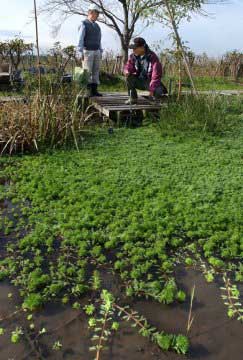 |
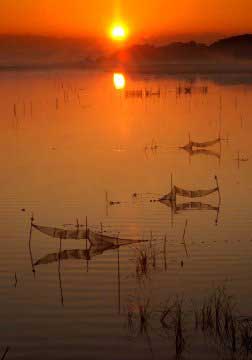 |
| 水を浄化しながらすくすく育つ藻 | 幻想的な風景。もっときれいになれるはず |
|
|
|
| ではこの「手賀沼ビオトープ」とは一体どのようなものなのでしょうか。手賀沼のほとり(約2万平方メートル)にポンプを使って沼から水を引きます。この水をゆっくりと流れるように蛇行させながら、色々な水生生物の中をくぐらせ植物の浄化作用を利用し、水をきれいにしようというものです。大きく分けると3つのゾーンに分かれています。最初に水が通るのは「手づくりのゾーン」と呼ばれるところで、ここは市民の皆さんが協力して水生生物の育成や管理を行っています。主に稲や蓮、空芯采、クワイ、クレソンなど水耕栽培ができ、なおかつ食べられる品種が植えられています。次に「生物を観測するゾーン」では生物の生息に配慮しながら、生息状況を観測するといったもので、ここでは抽水植物が自然に繁殖している中を水が流れていきます。最後に「生物の生息場とするゾーン」でここでは人の入り込みをできるだけ避け、生物の生息場として機能させます。ここでも抽水植物群落の中を蛇行しながら水が流れていきます。こうして3つのゾーンを通った水は植物の浄化作用により格段ときれいになり、また手賀沼へもどっていきます。実際、ビオトープに入っていく水と出ていく水を採取し、透明な入れ物にいれて比べたところ、確かに出て行く水は入っていく水よりきれいになっていました。 今回はこの「手づくりゾーン」で指揮をとる平成研究会会長の豊田敏則さん(71)にお話を伺いました。豊田さんは言います「もし沼全体の20%ほどを空芯采をつかって水耕栽培することができれば、沼の水は完全に浄化することができるのです。しかし、それを市民が勝手にすることはできません。手賀沼は国の持つ湖沼で、それを県が委託管理しています。ですから、多くの行政や団体の権利が重なりあい、市民が直接そこに介入するのは難しいのです。現在は唯一、漁業組合だけがこの手賀沼を利用することができます。」 こうした国や県、自治体と市民が一体となって取り組む環境対策は、これから先必要不可欠となるのでしょうが、あともう少しの改善や人々の協力が必要なのかもしれません。そうなれば、またいつの日か手賀沼に沢山のウナギが戻ってくる日もそう遠くない話なのかもしれません。 |
|
|
|
|
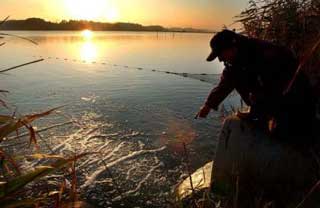 |
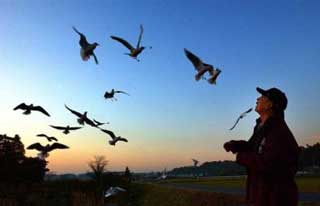 |
| ビオトープから沼に返る水。きれいになっている | 鳥たちも安全に暮らせる沼になるといいですね |
|
|
|
| おまけ 「小さな協力の手」 ビオトープにペットボトルを使って浮かんでいた縦横50cmくらい籠の中に、3つの違う野菜がすくすくと育っていました。これは魚とりがしたかったある少年が、豊田さんが作っていた水耕栽培に興味を持ち、彼の思うままに作ったものでした。5種類の野菜を植えたそうですが、なんと3種類も大きく育ったということで、この魚とりがしたかっただけの少年は、市から「手賀沼賞」なるものを受賞しました。少年は手賀沼で大きな獲物をすくったのです。 |
|
|
|
|
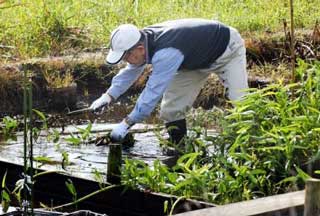 |
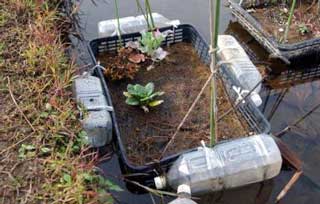 |
| ここは水質浄化の実験場と豊田さんはいいます | 仲良くなった少年が作ったもの |
|
|
|
| "Tega-numa biotope" Do you know the swamp which became dirty most in Japan? It is the swamp located in the northwestern part of Chiba Prefecture, and is Tega-numa with the circumference of 38km, a depth of 86cm, and an area of 6.5 square kilometers. Till the 1950s, this swamp was beautiful and was also the specialty ground of an eel. Most eels which eat in Tokyo were called "product from Tega-numa." However, this swamp was quickly polluted with the Tega-numa valley with the life waste water from a residence in the 1960s without fixing a sewer. This swamp is worst one with the COD value showing the degree of contamination of water quality in the whole country in 1974 and afterwards. In order to reproduce Tega-numa, the activity which the prefecture, the city, and the citizen are tackling together is the "Tega-numa biotope." A biotope (bio top) is the coined word which combined bio (living thing) and top (place), and it is defined as "the area which wildlife with a scene with a certain settlement inhabits." The "Tega-numa biotopes" is a series of processes of pouring the water of a swamp into various aquatic life living things, and making water purifying using a vegetable purification action. It is divided into three zones if it roughly divides. What water passes along first is "handmade zone." Here, the citizen is performing training and management of an aquatic life living thing. The hydroponics of a rice, a lotus, an arrowhead, and the watercress is carried out. The habitation situation of a living thing is observed in "the zone which observes a living thing", considering habitation of a living thing. "The zone made into the living space of a living thing" has a function as living space of a living thing. Here, while water moves the inside of a plant community in a zigzag direction, it flows. The water passing through these three zones is purified by vegetable purification action, and returns to Tega-numa. This time, we asked Mr. Toshinori Toyoda(71), the Heisei study group chairman, who takes command in this "handmade zone." Mr. Toyoda says. "By carrying out the hydroponics of the 20% of the whole swamp, the water of the swamp is purified completely. However, citizens cannot perform it freely. Tega-numa is the lake government has jurisdiction, and the prefecture is carrying out consignment management of it. Therefore, since much administration and an organization's rights overlap, it is difficult to concern citizens with purification of this swamp directly. Only local fishermen's union can use this Tega-numa. " The environmental measure which a country, a prefecture, a self-governing body, and citizens are united, and tackle will become indispensable from now on. However, we may need to ask for the further improvement and further cooperation. We expect realizing at the time when many eels return to Tega-numa. |
|
Copyright (C) 2001 Team ACP. All Rights Reserved.